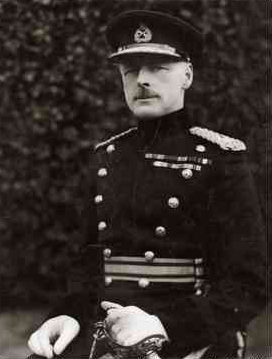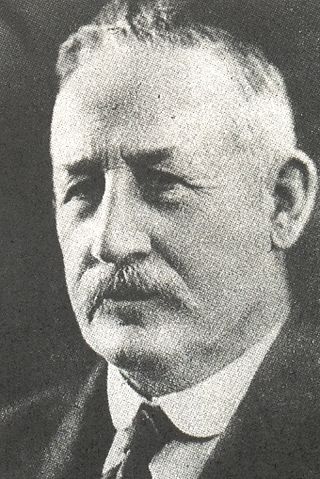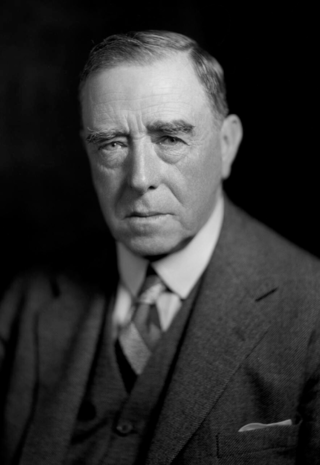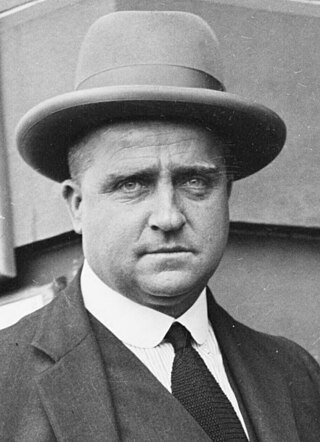
Major General Winston Joseph Dugan, 1st Baron Dugan of Victoria,, known as Sir Winston Dugan between 1934 and 1949, was a British administrator and a career British Army officer. He served as Governor of South Australia from 1934 to 1939, then Governor of Victoria until 1949.

John Cain was an Australian politician, who became the 34th premier of Victoria, and was the first Labor Party leader to win a majority in the Victorian Legislative Assembly. He is the only premier of Victoria to date whose son has also served as premier.

Sir Bertram Sydney Barnsdale Stevens, also referred to as B. S. B. Stevens, was an Australian politician who served as the 25th Premier of New South Wales, in office from 1932 to 1939 as leader of the United Australia Party (UAP).
Ian Macfarlan was the Deputy Leader of the Victorian Liberal Party during 1945. He was briefly commissioned as the 35th Premier of Victoria by the Governor and formed a government which brought about the end of the Dunstan Ministry.

John Allan was an Australian politician who served as the 29th Premier of Victoria. He was born near Lancefield, where his father was a farmer of Scottish origin, and educated at state schools. He took up wheat and dairy farming at Wyuna and was director of a butter factory at Kyabram. In 1892 he married Annie Stewart, with whom he had six children.

Edmond John "Ned" Hogan was an Australian politician who was the 30th Premier of Victoria. He was born in Wallace, Victoria, where his Irish-born parents were small farmers. After attending a Roman Catholic primary school, he became a farm worker and then a timber worker, and spent some time on the goldfields of Western Australia.
The following lists events that happened during 1935 in Australia.

Sir Stanley Seymour Argyle KBE, MRCS, LRCP, was an Australian radiologist and politician. He served as premier of Victoria from 1932 to 1935 and was the state leader of the Nationalist Party and United Australia Party from 1930 until his death in 1940.

Thomas Tuke Hollway was the 36th Premier of Victoria, and the first to be born in the 20th century. He held office from 1947 to 1950, and again for a short period in 1952. He was originally a member and the leader of the United Australia Party (UAP) in Victoria, and was the inaugural leader of the UAP's successor, the Victorian division of the Liberal Party, but split from the Liberals after a dispute over electoral reform issues.

George James Bowden MC was an Australian soldier and politician.

James Michael Sheehan was an Australian trade unionist and politician.

The 1932 New South Wales state election was held on 11 June 1932. This election was for all of the 90 seats in the 30th New South Wales Legislative Assembly and it was conducted in single member constituencies with compulsory preferential voting. It was a landslide victory for the UAP/Country Party coalition of Bertram Stevens, which had a majority of 42 in the Assembly.

The 1935 New South Wales state election was held on 11 May 1935. This election was for all of the 90 seats in the 31st New South Wales Legislative Assembly and was conducted in single member constituencies with compulsory preferential voting.

Thomas Tunnecliffe was an Australian politician. Representing the Australian Labor Party, he was a member of the Victorian Legislative Assembly for the electorates of West Melbourne (1903–1904), Eaglehawk (1907–1920) and Collingwood (1921–1947).

The Solicitor-General of Victoria, known informally as the Solicitor-General, is the state's Second Law Officer and the deputy of the Attorney-General. The Solicitor-General acts alongside the Crown Advocate and Crown Solicitor, and serves as one of the legal and constitutional advisers of the Crown and its government in the Australian state of Victoria.

Henry Peter Zwar, OBE was an Australian liberal/conservative politician, local government councillor, local government head, Member of Lower House and tannery owner.

The Stevens–Bruxner ministry (1935–1938) or Second Stevens–Bruxner ministry or Second Stevens ministry was the 47th ministry of the New South Wales Government, and was led by the 25th Premier, Bertram Stevens, in a United Australia Party coalition with the Country Party, that was led by Michael Bruxner. The ministry was the second one of three occasions when the Government was led by Stevens, as Premier; and second of four occasions where Bruxner served as Deputy Premier.

The 1935 Victorian state election was held in the Australian state of Victoria on Saturday 2 March 1935 to elect 53 of the 65 members of the state's Legislative Assembly. 12 seats were uncontested.

The 1932 Victorian state election was held in the Australian state of Victoria on Saturday 14 May 1932 to elect 44 of the 65 members of the state's Legislative Assembly. The other 21 seats were uncontested.
Sir Albert Louis (Lou) Bussau was a farmer, a Victorian politician, and the Victorian Agent General in London.














